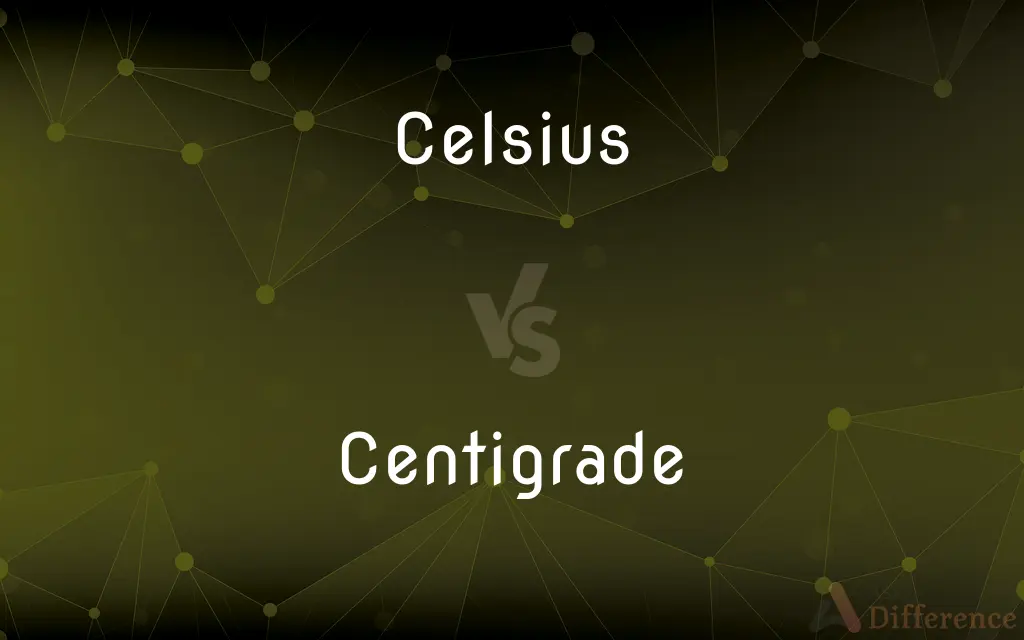Celsius vs. Centigrade — What's the Difference?
By Tayyaba Rehman — Updated on September 17, 2023
Celsius is a temperature scale where 0° represents the freezing point of water and 100° its boiling point at sea level; Centigrade, its former name, means "divided into 100 degrees."

Difference Between Celsius and Centigrade
Table of Contents
ADVERTISEMENT
Key Differences
Celsius is the term used today to denote the temperature scale based on 0° as the freezing point of water and 100° as its boiling point at sea level. Centigrade was the term originally used for this scale, reflecting the Latin roots "centi-" (meaning 100) and "gradus" (meaning steps or degrees).
The Celsius scale is a part of the metric system and is widely used globally for most temperature measurements, especially in scientific contexts. Centigrade, while essentially the same as Celsius, is a term that's becoming more antiquated.
It's interesting to note that despite their different names, Celsius and Centigrade represent the same temperature values. They were only renamed to honor the Swedish astronomer Anders Celsius, who developed the scale.
Using Celsius is more prevalent in modern communication, especially in international contexts. On the other hand, using Centigrade may be encountered in older texts, documents, or in conversations with individuals who still use the traditional term.
Whether one uses Celsius or Centigrade, the underlying concept remains consistent: a temperature scale that easily denotes the freezing and boiling points of water, aiding in its universal acceptance and application.
ADVERTISEMENT
Comparison Chart
Definition
Temperature scale from 0° to 100°
Same as Celsius
Origin of Name
Named after Anders Celsius
Latin roots "centi-" and "gradus"
Usage
Modern, international
Older texts, traditional contexts
Values
0° freezing, 100° boiling
Same as Celsius
Associated With
Metric system, scientific contexts
Historical, older usage
Compare with Definitions
Celsius
Named after Anders Celsius.
Anders Celsius introduced the Celsius scale in the 18th century.
Centigrade
Derived from Latin meaning 100 degrees.
Centigrade literally means divided into 100 degrees.
Celsius
A metric temperature scale.
The weather today is 25° Celsius.
Centigrade
Less common in modern usage.
Older books might reference temperatures in Centigrade.
Celsius
Widely accepted global temperature scale.
Most countries measure temperature in Celsius.
Centigrade
A temperature scale from 0° to 100°.
It's 10° Centigrade outside.
Celsius
0° freezing and 100° boiling for water.
Ice melts at 0° Celsius.
Centigrade
Precursor name to Celsius.
My grandmother still uses the term Centigrade.
Celsius
Used in scientific measurements.
The lab results were recorded in Celsius.
Centigrade
Celsius.
Celsius
The degree Celsius is a unit of temperature on the Celsius scale, a temperature scale originally known as the centigrade scale. The degree Celsius (symbol: °C) can refer to a specific temperature on the Celsius scale or a unit to indicate a difference or range between two temperatures.
Centigrade
(of a scale) Having 100 divisions between two fixed points.
Celsius
Of or relating to a temperature scale that registers the freezing point of water as 0° and the boiling point as 100° under normal atmospheric pressure. See Table at measurement.
Centigrade
Celsius (since 1948).
Celsius
Alternative case form of Celsius
Centigrade
(uncountable) A centigrade temperature scale having the freezing point of water defined as 0° and its boiling point defined as 100° at standard atmospheric pressure. Although formally known as the Celsius scale since 1948, centigrade is still the more commonly found term.
Celsius
The Celsius thermometer or scale, so called from Anders Celsius, a Swedish astronomer, who invented it. It is the same as the centigrade thermometer or scale.
Centigrade
A single degree on this scale.
A temperature of 34 centigrades
Celsius
Swedish astronomer who devised the centigrade thermometer (1701-1744)
Centigrade
(countable) A unit of angle equal to the hundredth part of a quadrant. Its symbol is gon.
Centigrade
Consisting of a hundred degrees; graduated into a hundred divisions or equal parts.
Centigrade
Represents same values as Celsius.
Whether it's 30° Celsius or Centigrade, it's the same temperature.
Common Curiosities
Are Celsius and Centigrade the same?
Yes, they represent the same temperature scale, just different names.
Why was the name changed to Celsius?
It was renamed to honor Anders Celsius, who developed the scale.
Is Centigrade still used today?
It's less common, but you might encounter it in older texts or with those who prefer traditional terms.
Why is 0° chosen as the freezing point in this scale?
It represents the freezing point of water at sea level.
Which countries mainly use Celsius?
Most countries globally, except for a few like the U.S. which uses Fahrenheit.
Is there any difference in values between them?
No, they represent the exact same temperature values.
Does "Celsius" have Latin roots like "Centigrade"?
No, it's named after a person, Anders Celsius.
What symbol represents Celsius?
The symbol for Celsius is "°C."
What does "centi-" in Centigrade signify?
"Centi-" from Latin means 100, signifying the 100-degree division between freezing and boiling.
Is Celsius used in scientific research?
Yes, Celsius is commonly used in scientific contexts.
Which term is older, Celsius or Centigrade?
Centigrade is the older term.
How does Celsius compare to Fahrenheit?
Celsius is based on water's freezing and boiling points, while Fahrenheit is based on different reference points.
Are there other temperature scales besides these?
Yes, such as Fahrenheit, Kelvin, and Rankine.
Why are there multiple temperature scales?
They were developed at different times and places, based on different reference points and needs.
Is the term Centigrade outdated?
It's less common in modern usage but isn't incorrect.
Share Your Discovery

Previous Comparison
Referee vs. Arbiter
Next Comparison
Sufficiency vs. EfficiencyAuthor Spotlight
Written by
Tayyaba RehmanTayyaba Rehman is a distinguished writer, currently serving as a primary contributor to askdifference.com. As a researcher in semantics and etymology, Tayyaba's passion for the complexity of languages and their distinctions has found a perfect home on the platform. Tayyaba delves into the intricacies of language, distinguishing between commonly confused words and phrases, thereby providing clarity for readers worldwide.















































